When Crystal and I visited Angkor Wat in 2007 there were thousands of other tourists present. We took the advice of a guidebook to start our day with sunrise at Bayon in order to stay one step ahead of the crowds but often still found ourselves surrounded by a throng. I’ve heard that the daily visitors has increased into the ten of thousands as Cambodian tourism has grown.
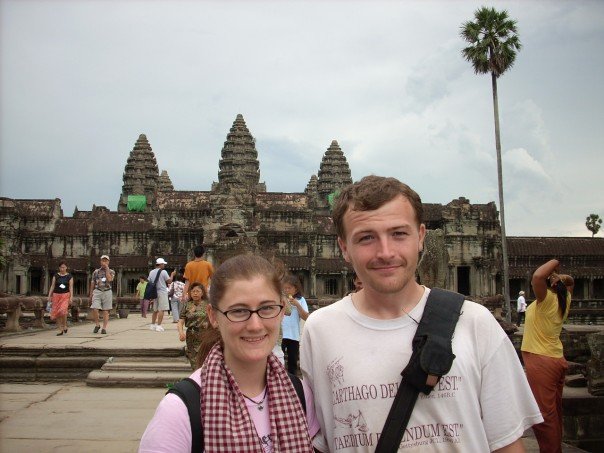
When we visited Angkor Wat in 2020, there were dozens of other people at Angkor Wat, only a handful of people at Bayon and Ta Prohm, and no one at the other temples we visited. We only came across a single Korean tour group and the vast majority of the visitors were Cambodian locals. This was, of course, due to the COVID-19 pandemic. This made the trip very special – perhaps even once in a lifetime (unless I can convince the family to go to Siem Reap again instead of the beach before tourist visas return).
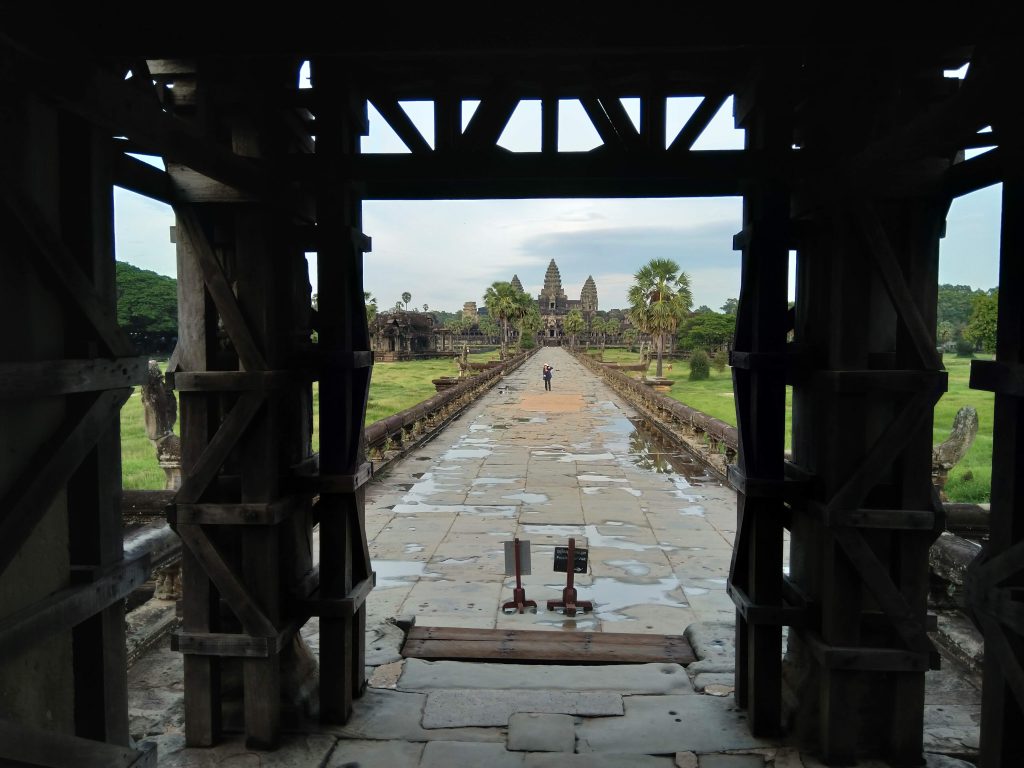
Background
Built in the early 12th century, Angkor Wat was intended to be the state temple for the ancient Khmer empire. Originally designed as a Hindu temple it was later converted to Buddhism. It remains the largest religious structure in the world by land area – approximately four times larger than Vatican city – and is one of the most famous buildings in the world.
Angkor Wat is unusual among the Angkor temples in that although it was largely neglected after the 16th century, it was never completely abandoned. Fourteen inscriptions dated from the 17th century, discovered in the Angkor area, testify to Japanese Buddhist pilgrims that had established small settlements alongside Khmer locals. At that time, the temple was thought by the Japanese visitors to be the famed Jetavana garden of the Buddha, which was originally located in the kingdom of Magadha, India. The best-known inscription tells of Ukondayu Kazufusa, who celebrated the Khmer New Year at Angkor Wat in 1632.
One of the first Western visitors to the temple was António da Madalena, a Portuguese friar who visited in 1586 and said that it “is of such extraordinary construction that it is not possible to describe it with a pen, particularly since it is like no other building in the world. It has towers and decoration and all the refinements which the human genius can conceive of.”
Excerpt of Wikipedia entry on Angkor Wat, https://en.wikipedia.org/wiki/Angkor_Wat
The Moat
The incredible moat surrounding Angor Wat is 623 feet wide and it’s builders removed over 53 million cubic feet of sand and silt. The original stone bridge was closed for reconstruction in 2020 when we were there so we crossed the moat on a temporary floating bridge.
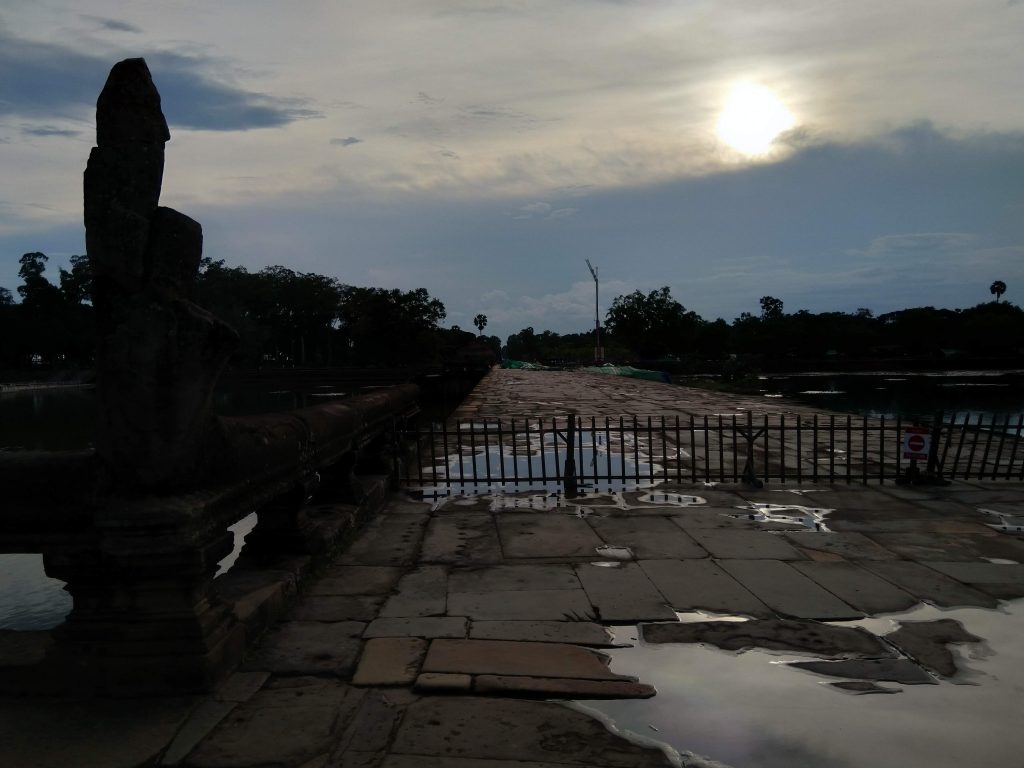
The original stone bridge is closed for reconstruction. 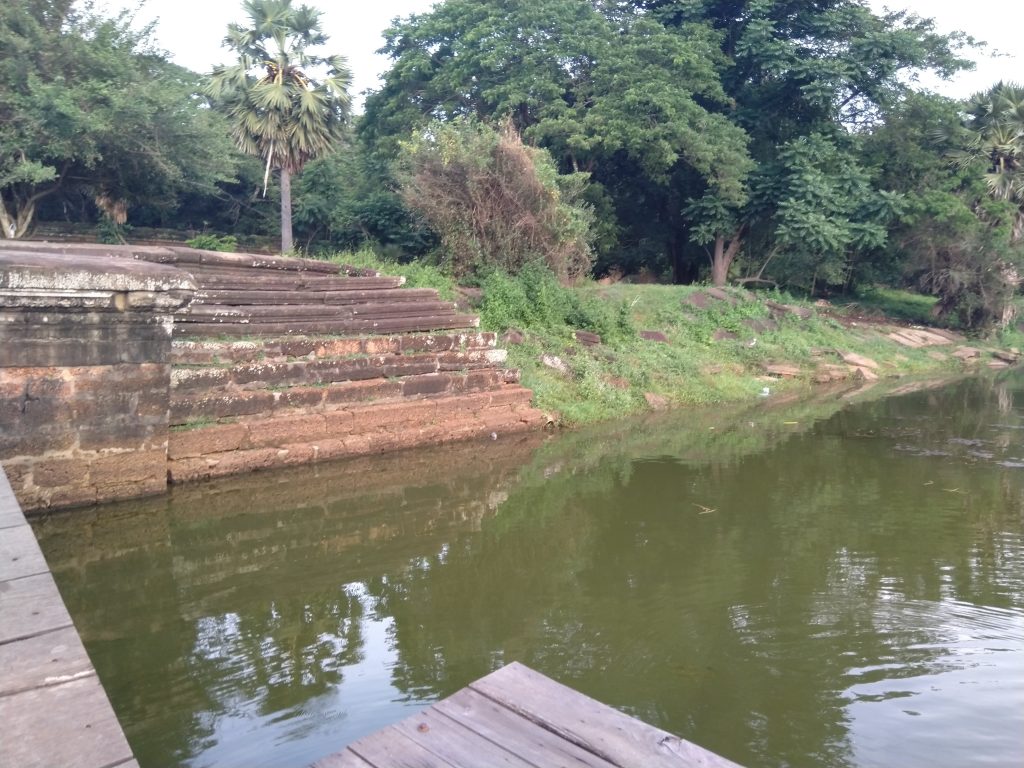
Stonework once lined the entire moat. 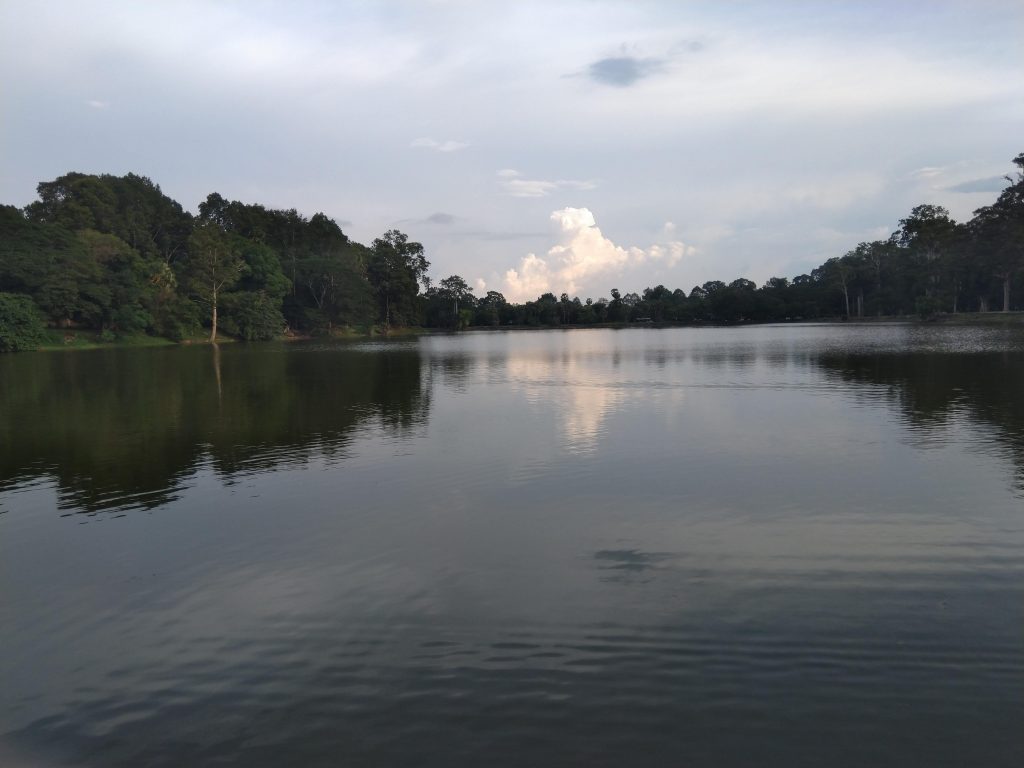
The view of the moat from the floating bridge. 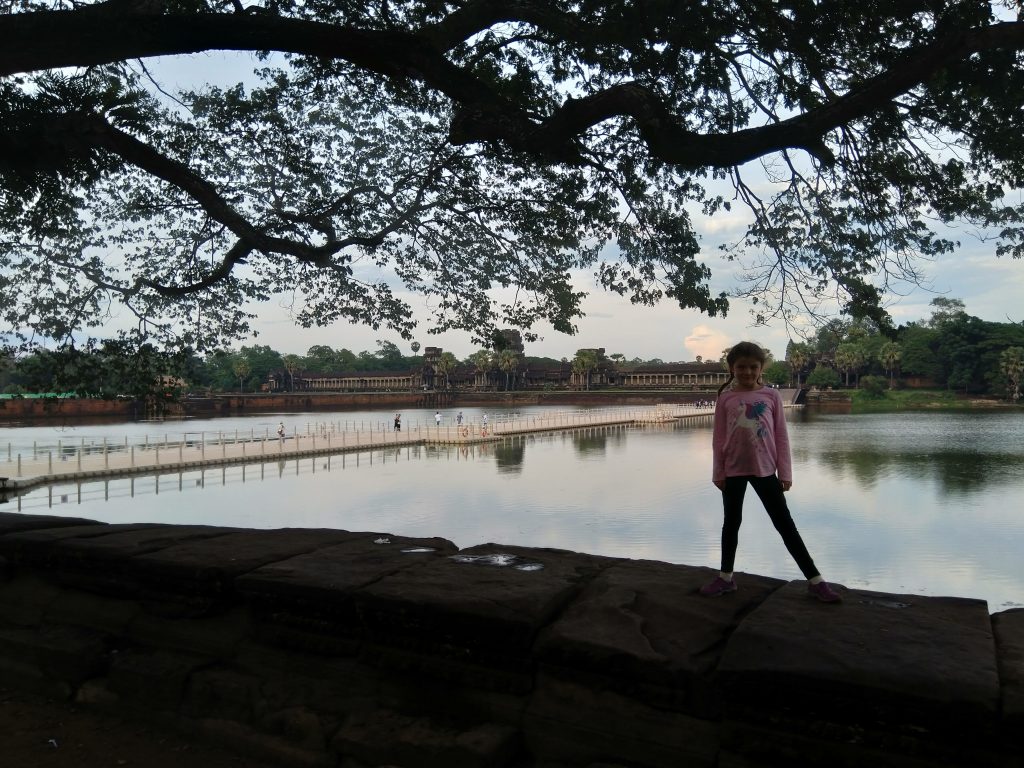
Charlotte standing on the outside edge of the moat.
The entrance, temporary floating bridge, and original bridge under reconstruction are in the background.
Catherine enjoyed hopping on the floating bridge so I went ahead to the entrance with Charlotte while Crystal stayed behind.
Inside Angkor Wat
The monument was made out of five to ten million sandstone blocks with a maximum weight of 1.5 tons each. The entire city of Angkor used far greater amounts of stone than all the Egyptian pyramids combined, and occupied an area significantly greater than modern-day Paris. Moreover, unlike the Egyptian pyramids which use limestone quarried barely 0.5 km (1⁄4 mi) away all the time, the entire city of Angkor was built with sandstone quarried 40 km (25 mi) (or more) away.
This sandstone had to be transported from Mount Kulen, a quarry approximately 40 kilometres (25 mi) northeast. The route has been suggested to span 35 kilometres along a canal towards Tonlé Sap lake, another 35 kilometres crossing the lake, and finally 15 kilometres against the current along Siem Reap River, making a total journey of 90 kilometres. However, Etsuo Uchida and Ichita Shimoda of Waseda University in Tokyo, Japan have discovered in 2011 a shorter 35-kilometre (22 mi) canal connecting Mount Kulen and Angkor Wat using satellite imagery. The two believe that the Khmer used this route instead.
Virtually all of its surfaces, columns, lintels, and even roofs are carved. There are kilometres of reliefs illustrating scenes from Indian literature including unicorns, griffins, winged dragons pulling chariots as well as warriors following an elephant-mounted leader and celestial dancing girls with elaborate hairstyles. The gallery wall alone is decorated with almost 1,000 m2 (11,000 sq ft) of bas reliefs. Holes on some of the Angkor walls indicate that they may have been decorated with bronze sheets. These were highly prized in ancient times and were a prime target for robbers
Excerpt of Wikipedia entry on Angkor Wat, https://en.wikipedia.org/wiki/Angkor_Wat
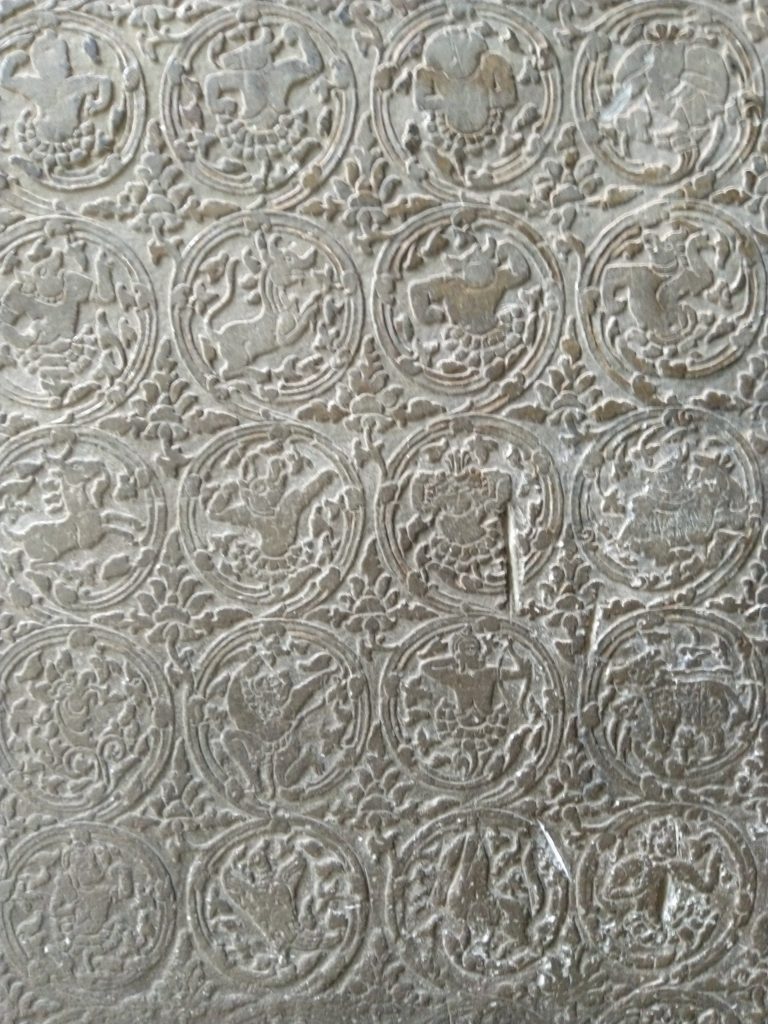
Intricate bas reliefs. Not sure of the symbolism? 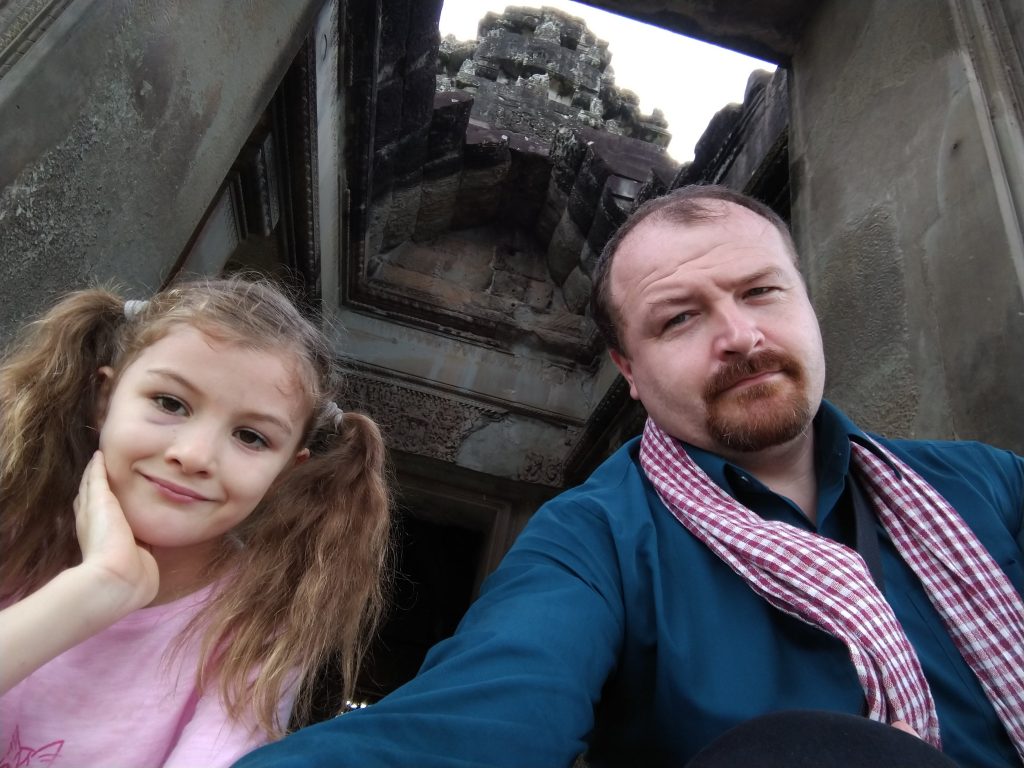
Charlotte and I inside the outer wall. 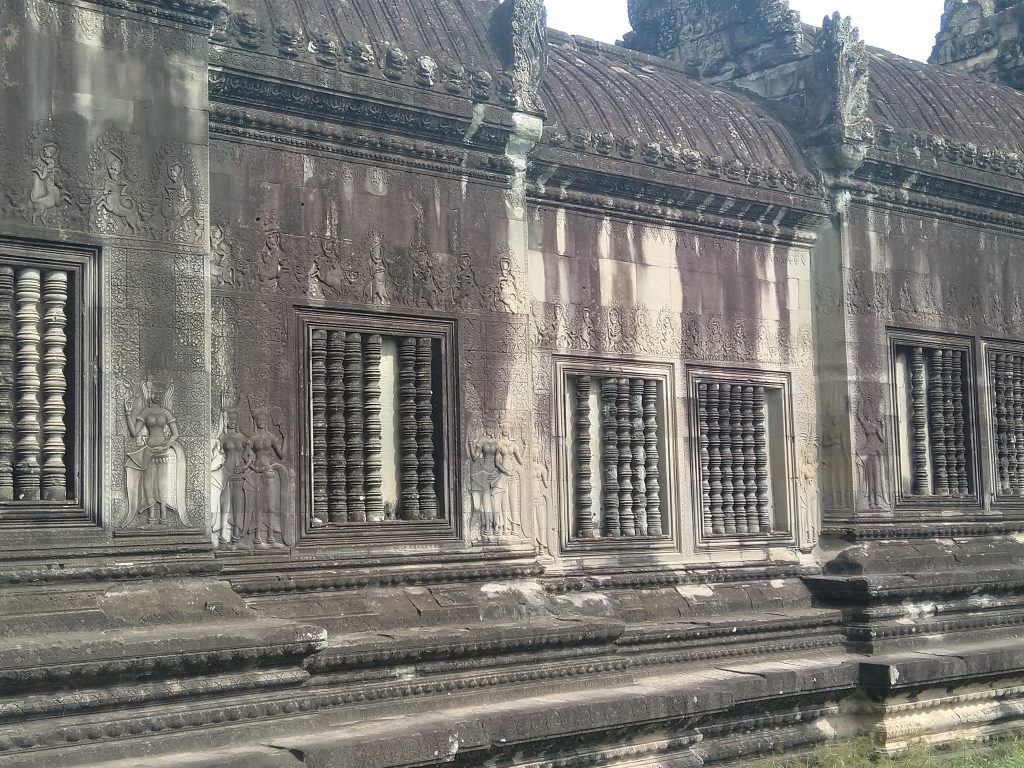
The outer wall viewed from inside. 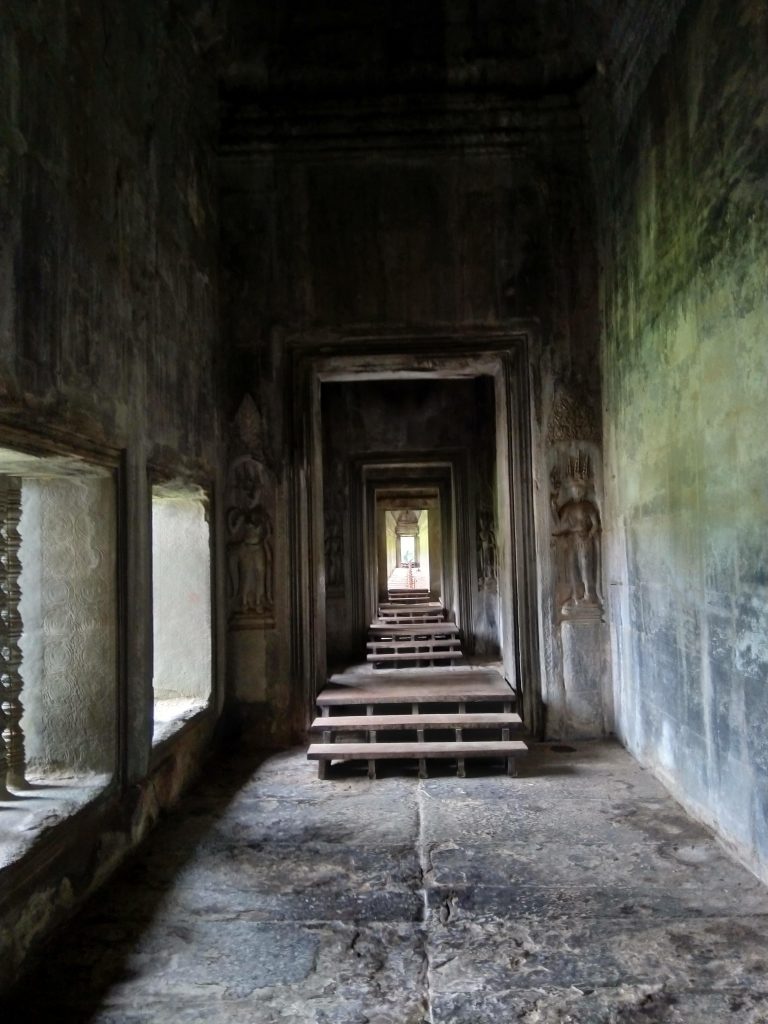
The shining halls of the outer wall are masterpieces of light and stone. 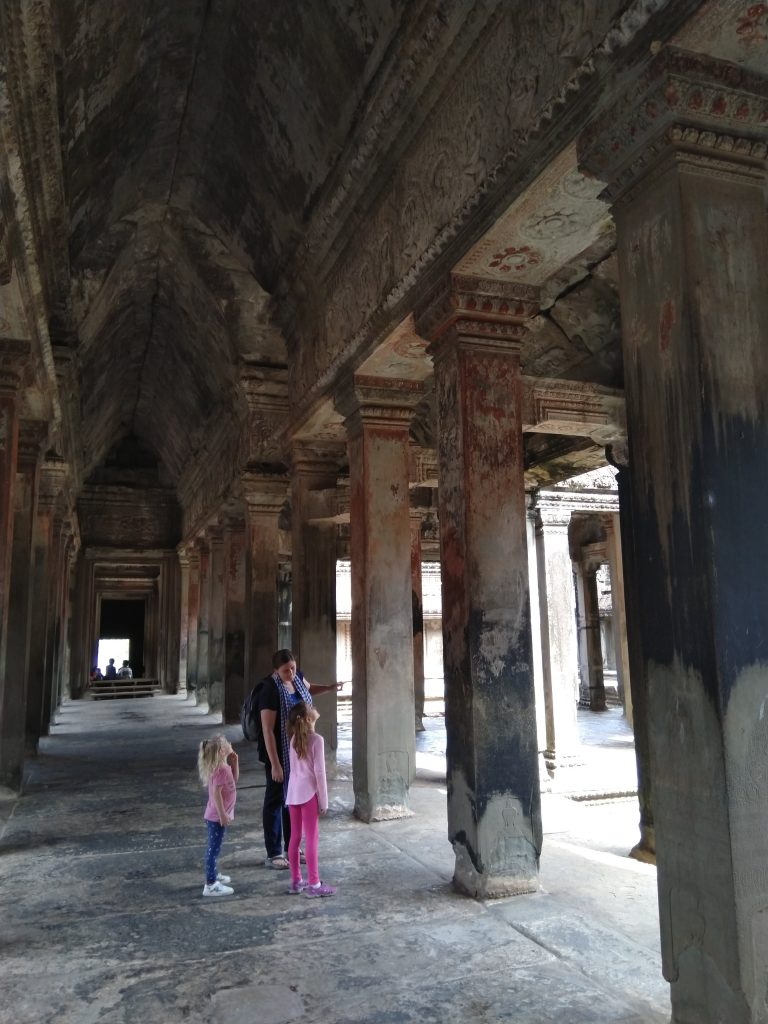
Looking at bas reliefs. 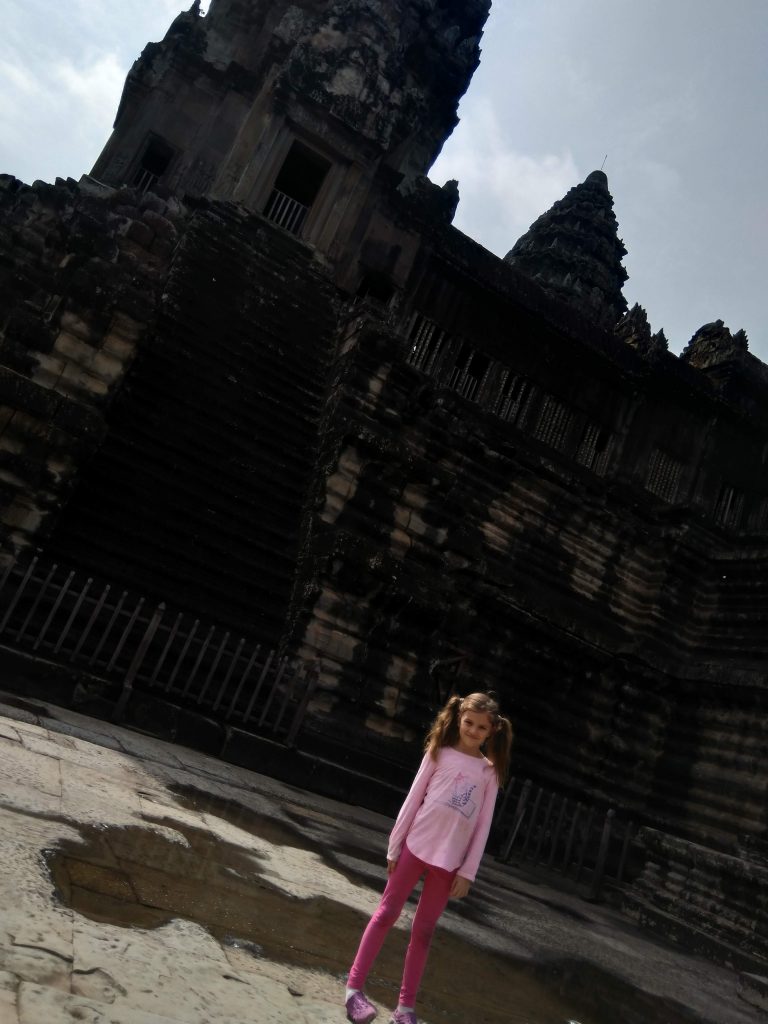
Charlotte with the center of Angor Wat behind her. 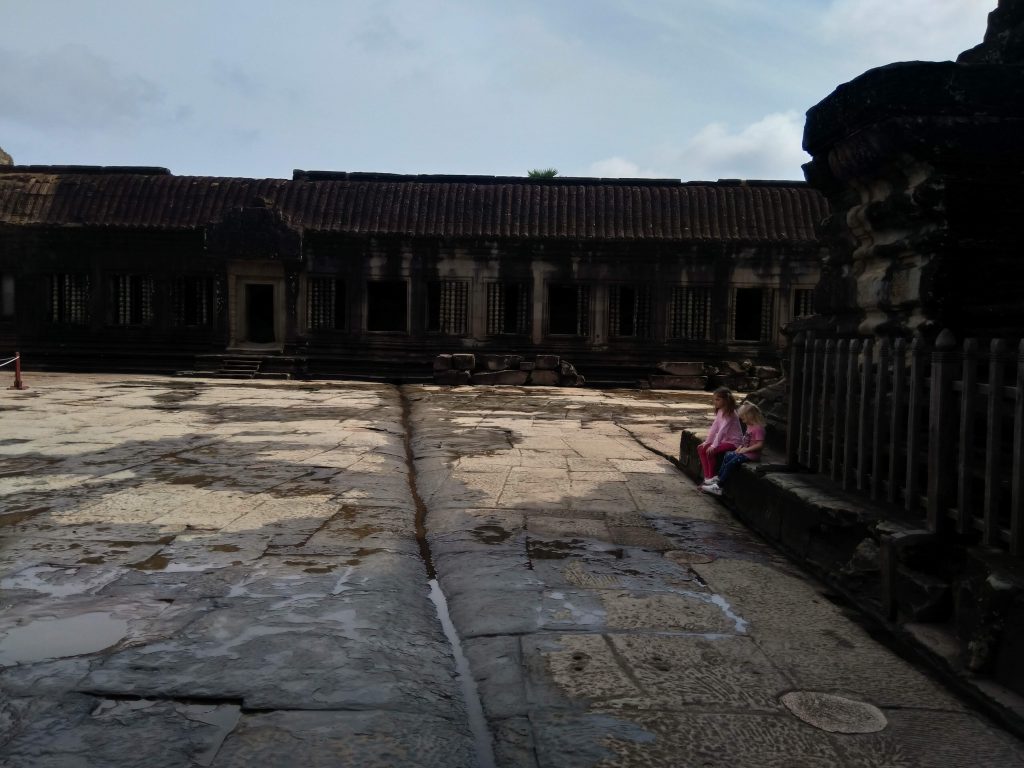
Taking a rest below the center of Angor Wat. 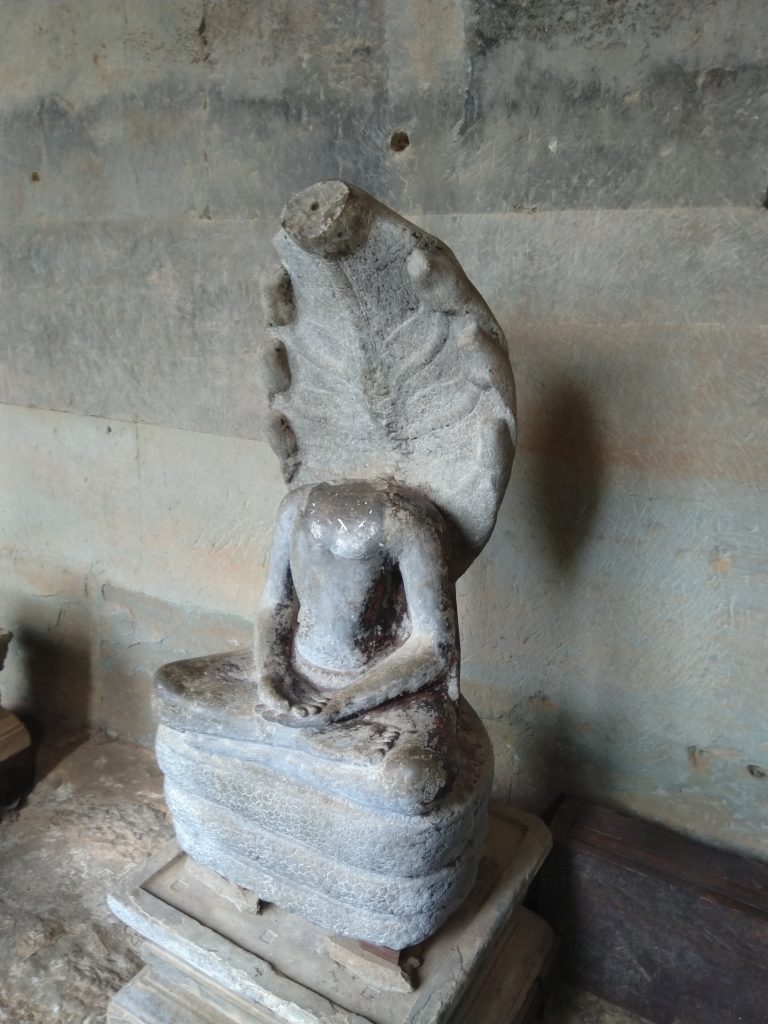
A beheaded Buddha statue with a naga.
As beliefs shifted and then shifted again, Hindu rulers would have Buddha statues beheaded and discarded. Then later Buddhist rulers would have them restored or enshrined.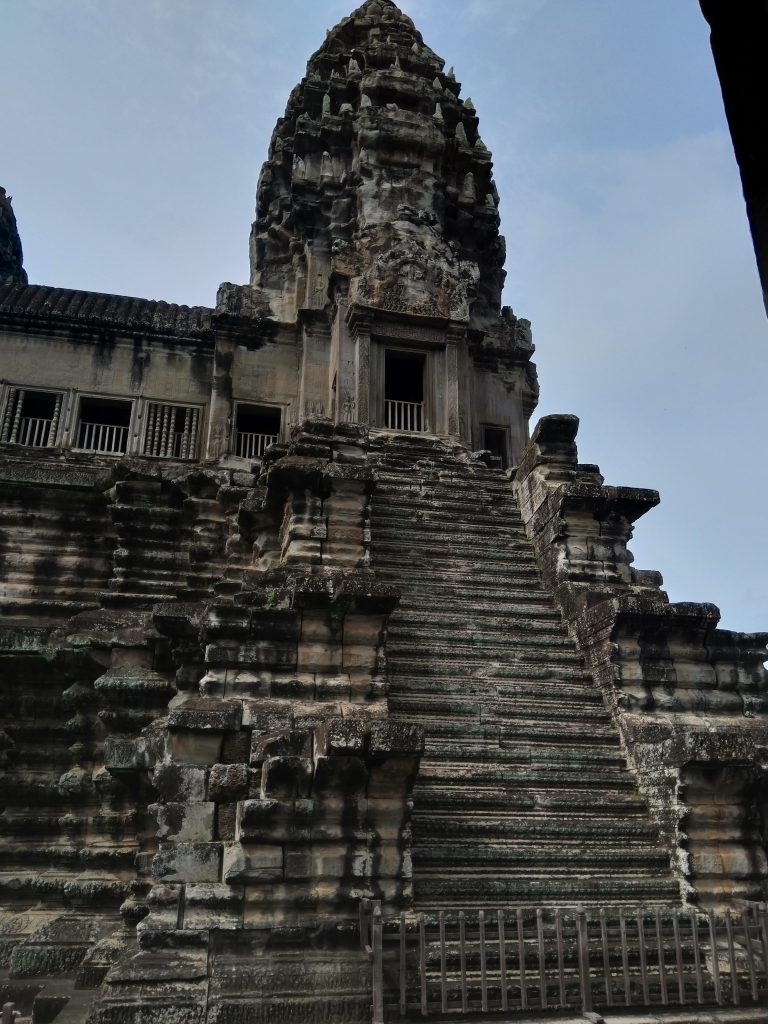
Most entrances to the center of Angkor Wat were closed. 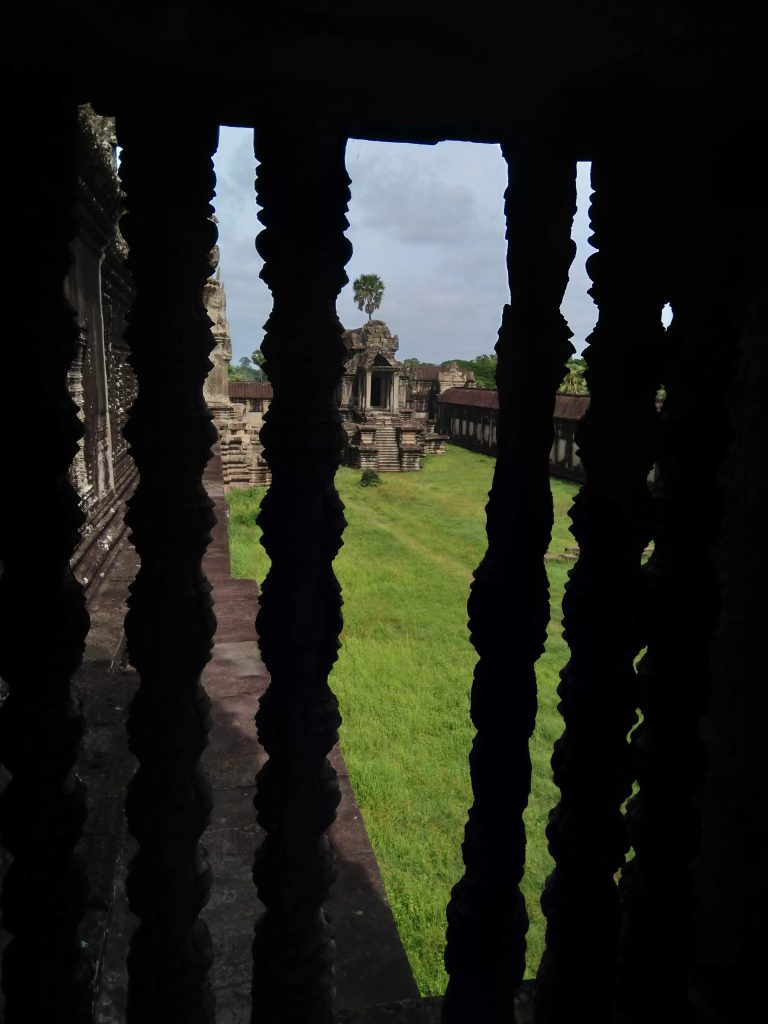
Looking out a window. 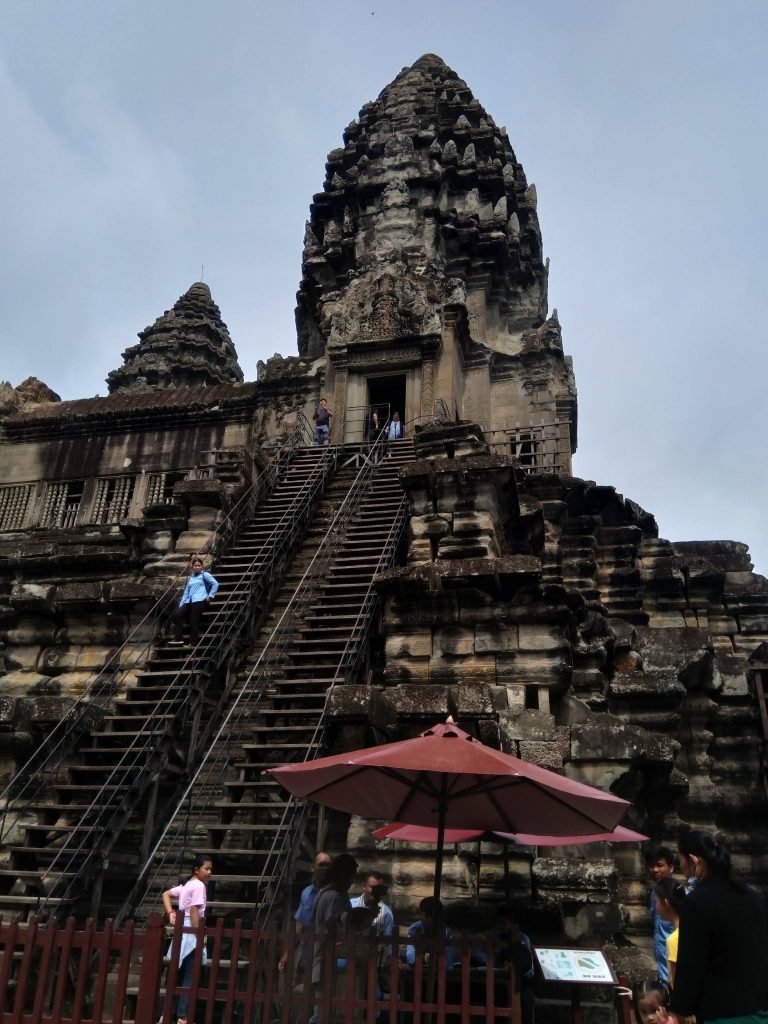
The center of Angkor Wat. 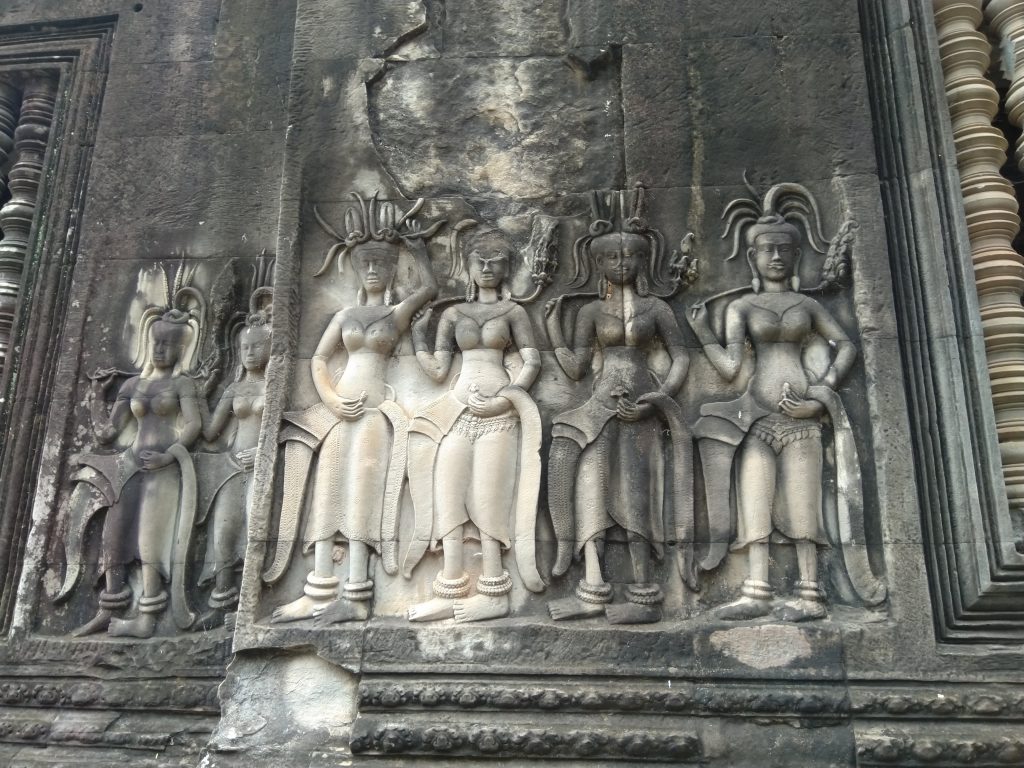
Reliefs of Apsara, also known as ‘celestial nymphs’, are everywhere at Angor Wat. 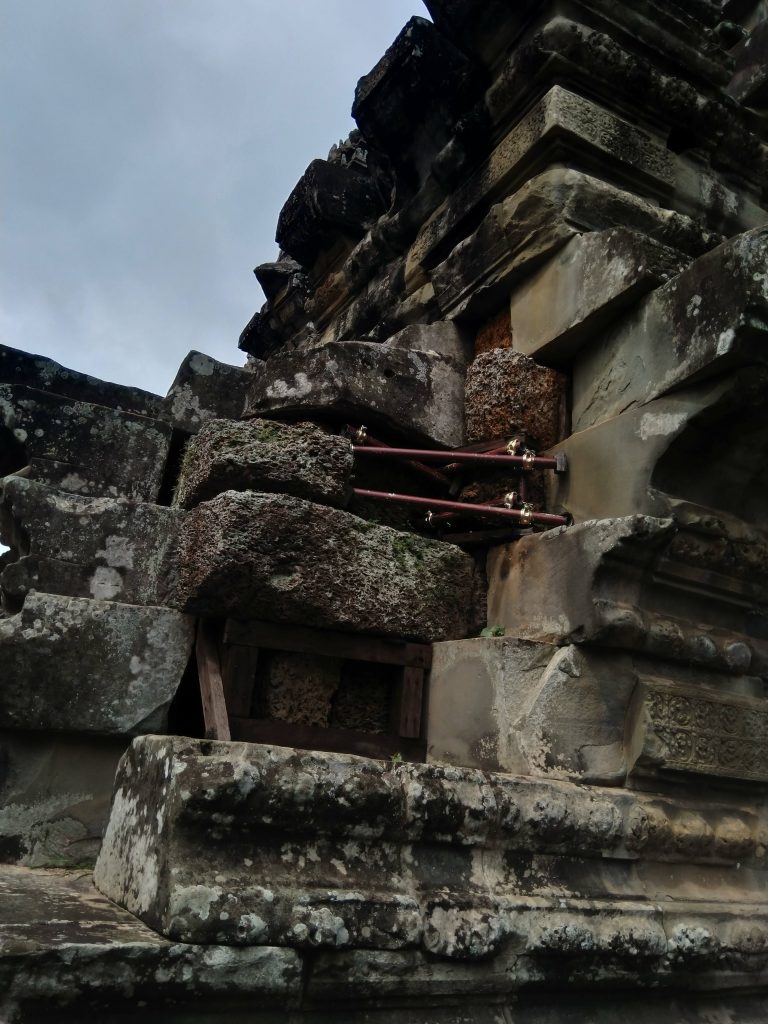
Modern structural supports. 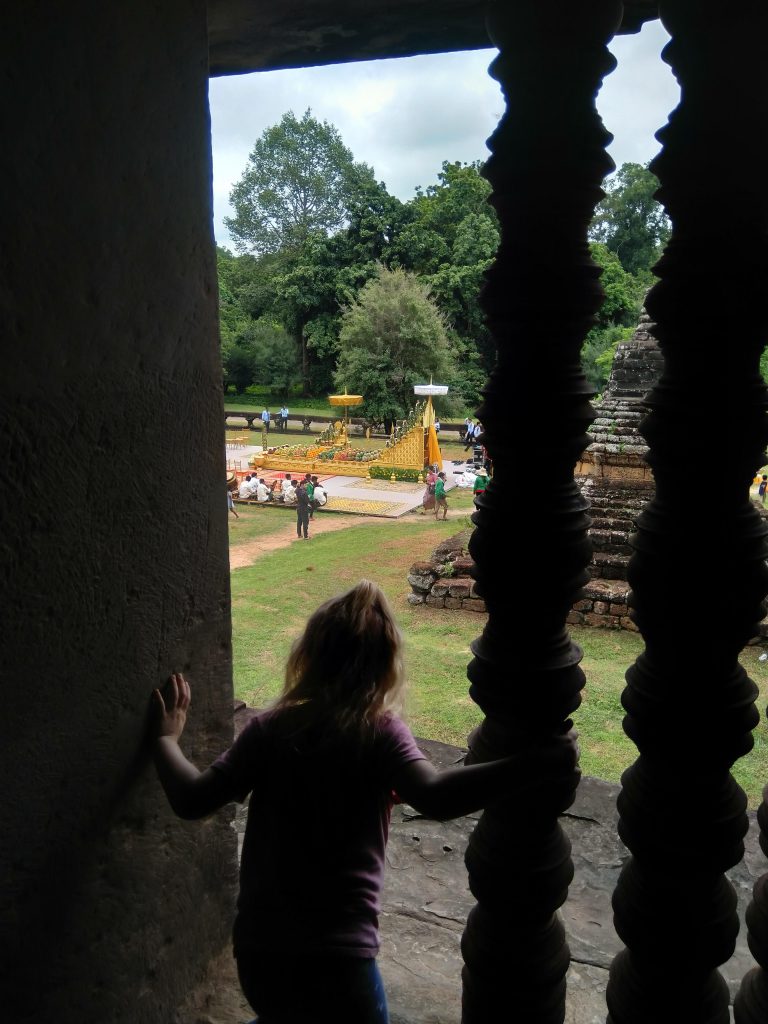
A ceremony of some sort was taking place behind Angor Wat. 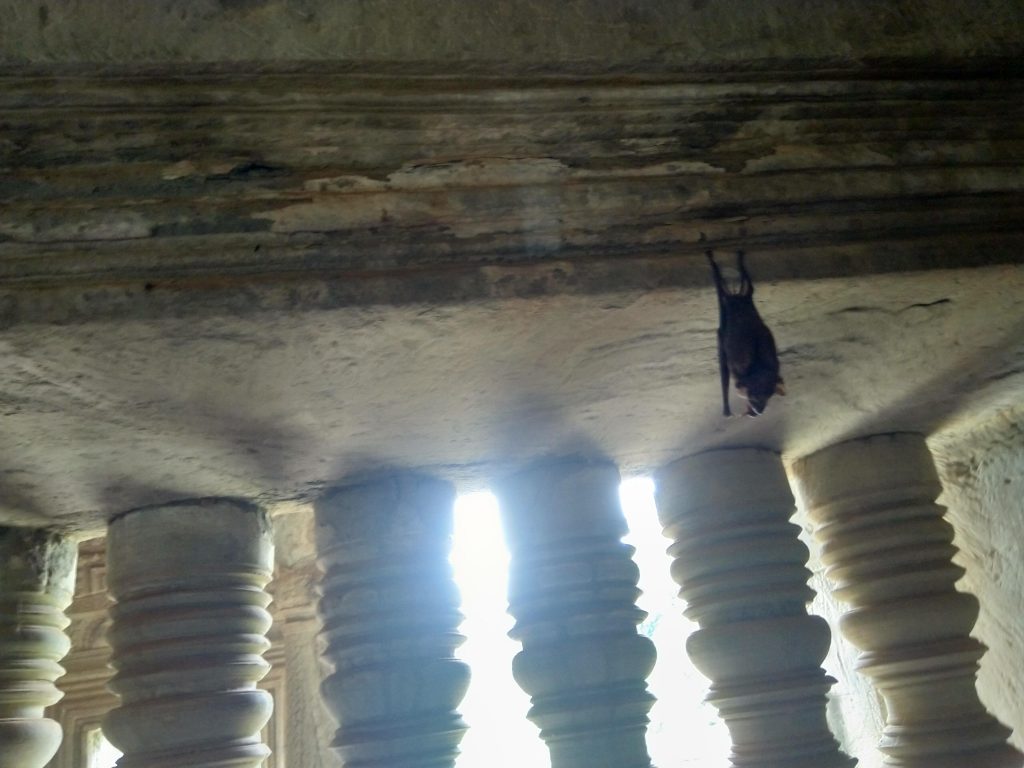
Hello there, bat! 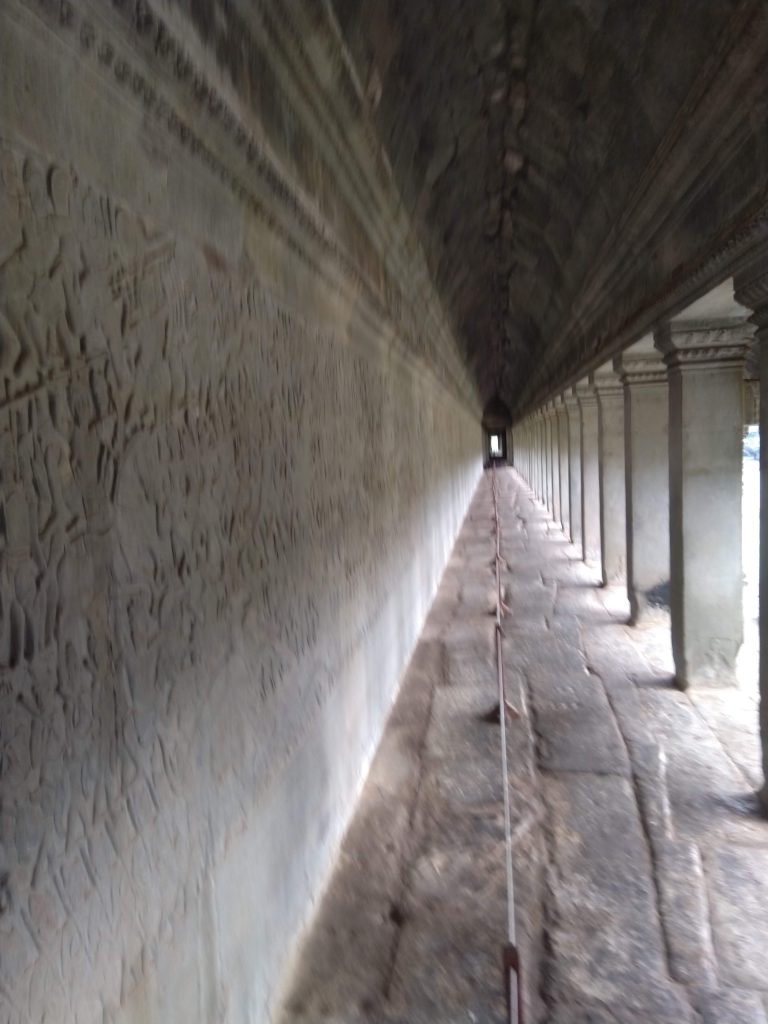
Incredible bas relief. 
Rhinoceros bas relief. I teased Charlotte that I had found a unicorn.
Many historians believe that the idea of unicorns came from ancient attempts to describe the Rhinoceros. Consider this from Pliny the Elder, “A very fierce animal called the monoceros which has the head of the stag, the feet of the elephant, and the tail of the boar, while the rest of the body is like that of the horse; it makes a deep lowing noise, and has a single black horn, which projects from the middle of its forehead.”
There was a rule that no one under the age of 12 was able to enter the center of Angor Wat. So Crystal went up alone while I waited below with Charlotte and Catherine. There’s normally a massive waiting line here to ascend to the top of Angor Wat, and this is where we encountered the only tour group of our visit, but Crystal only needed to wait a few minutes before she could head up.
After Crystal rejoined us, we explored more of the corridors behind Angor Wat and then found a quiet area where the girls decided to chase butterflies.
It felt strange and yet completely nature for the girls to chase butterflies in the middle of Angor Wat.
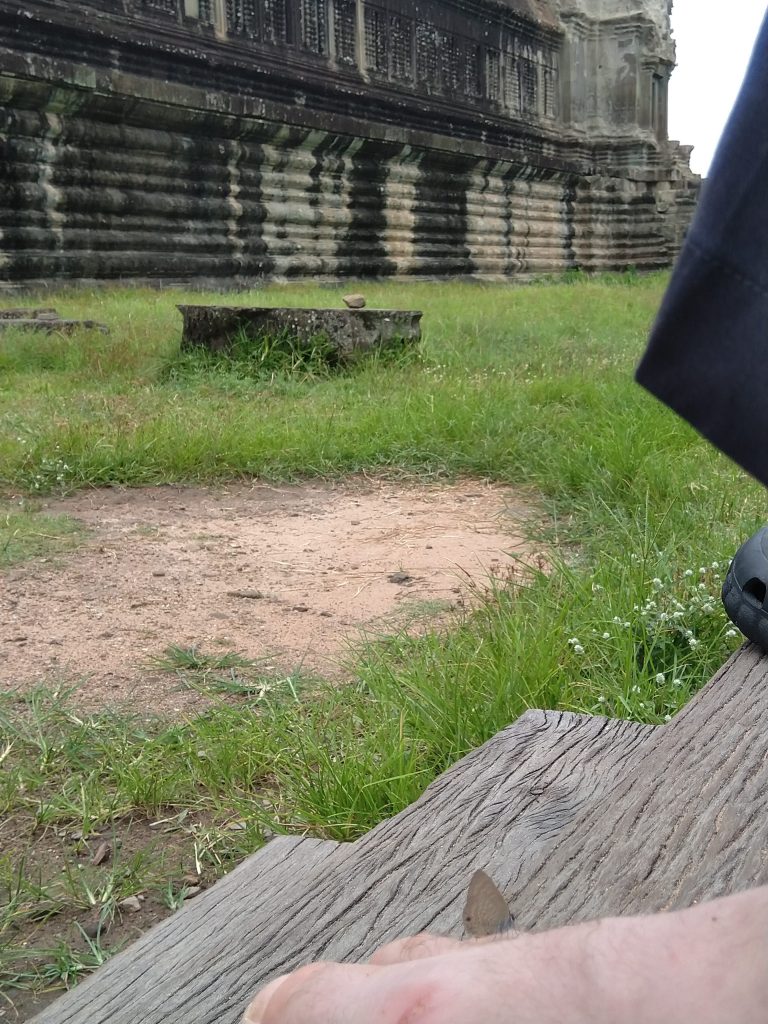
Leaving Angor Wat
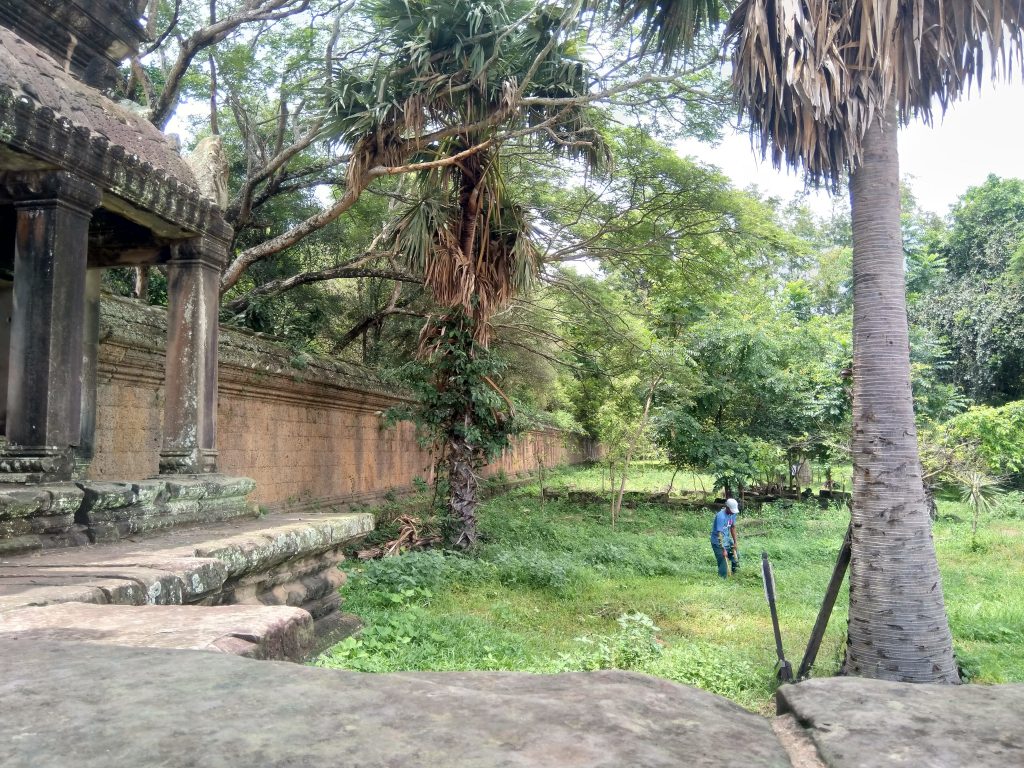
A worker pulling up a young tree by it’s roots. 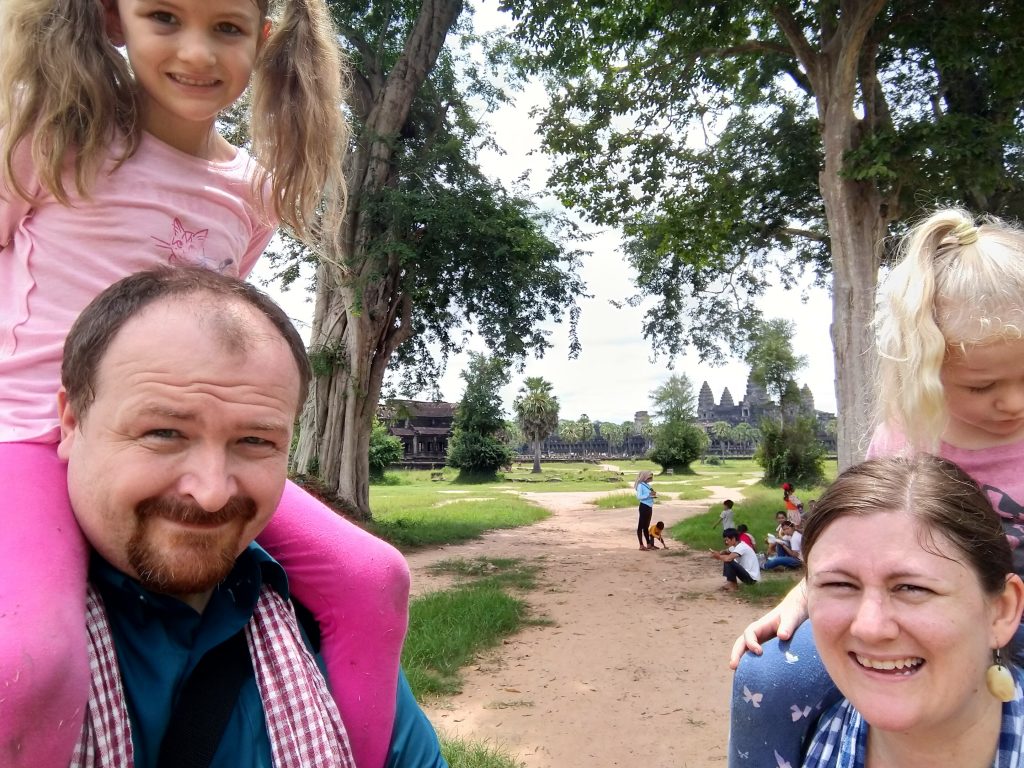
Looking back at Angor Wat and some Cambodian locals. 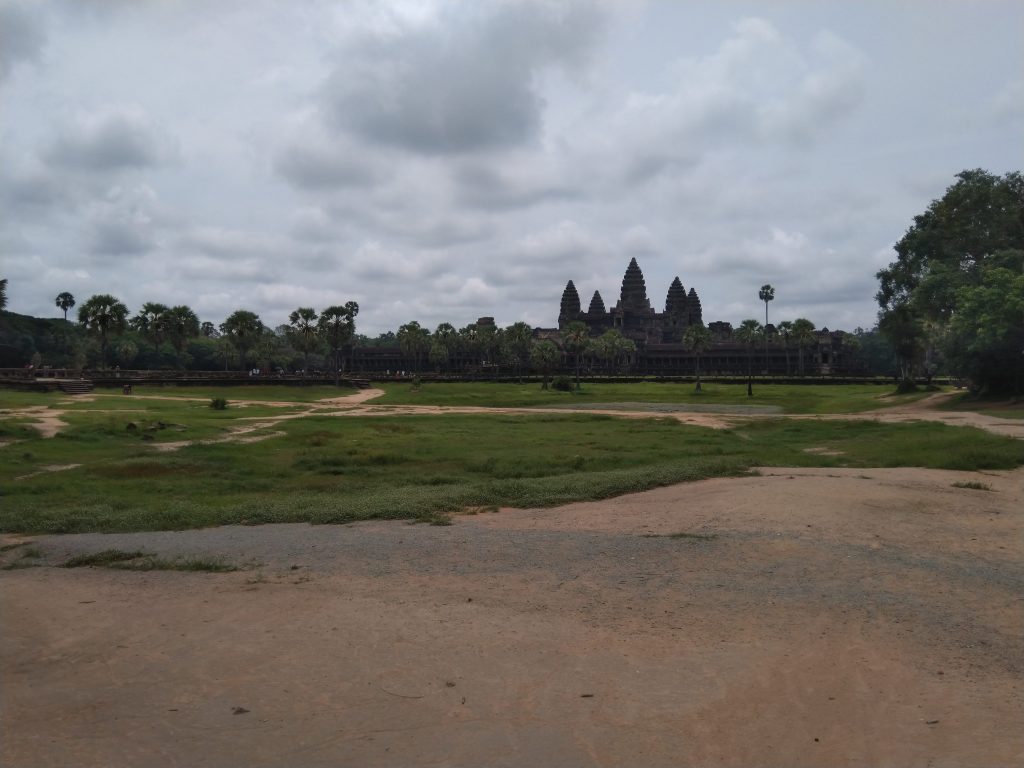
Another view of Angor Wat. 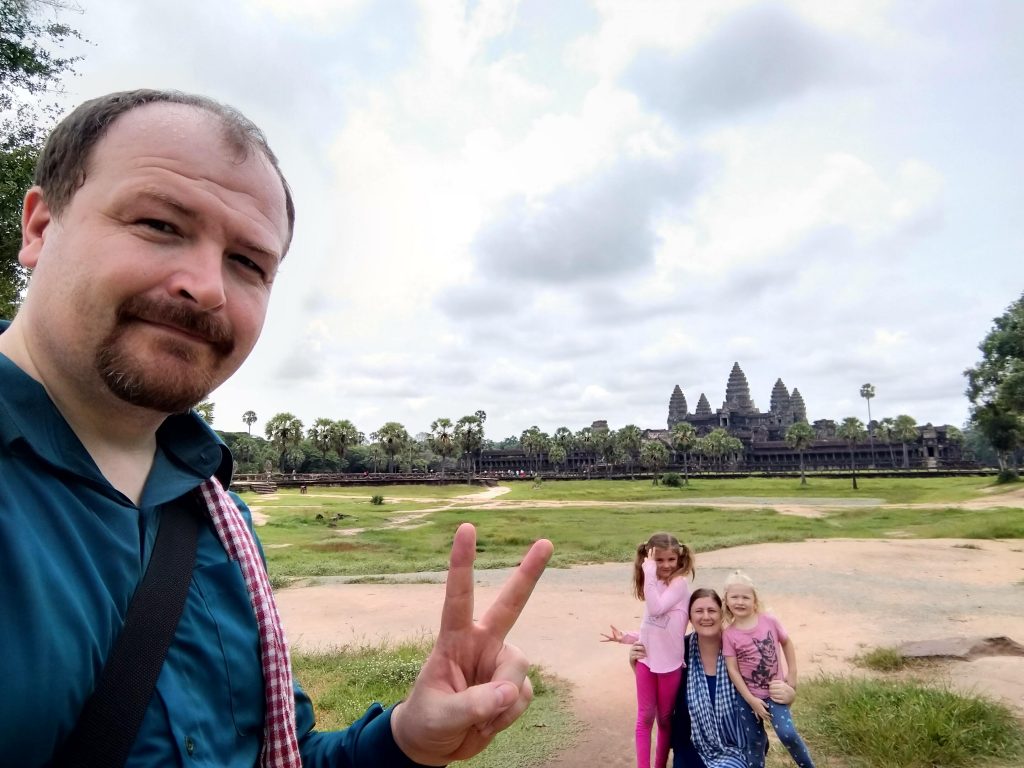
The same view but with us in it. 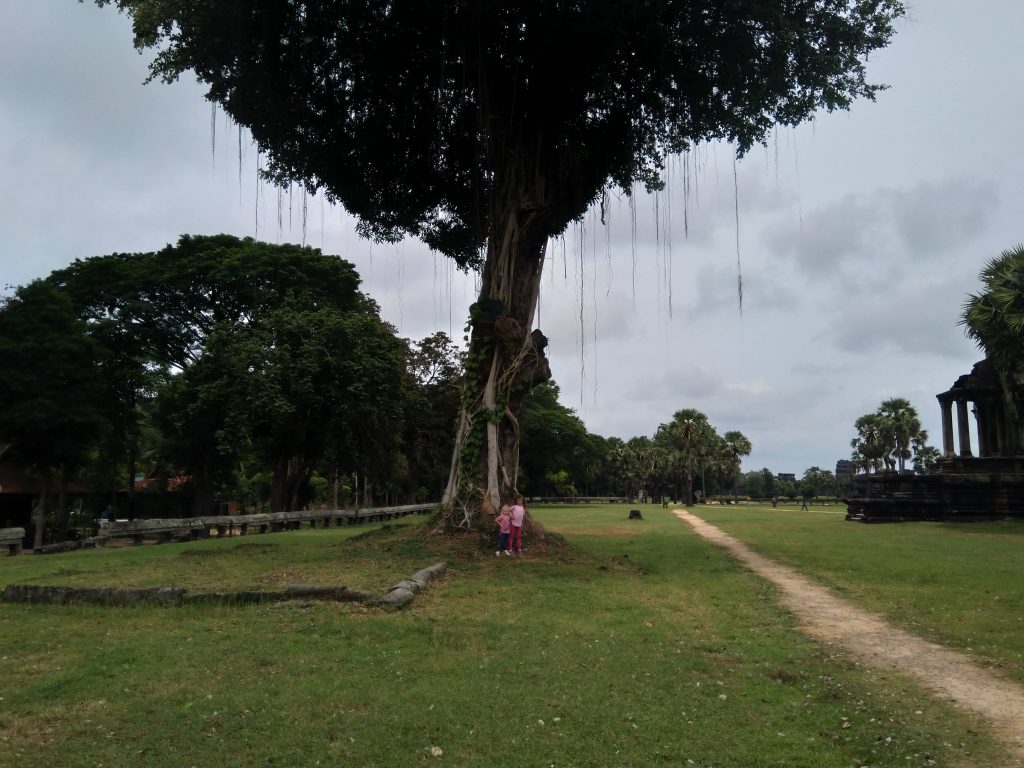
Another amazing tree. 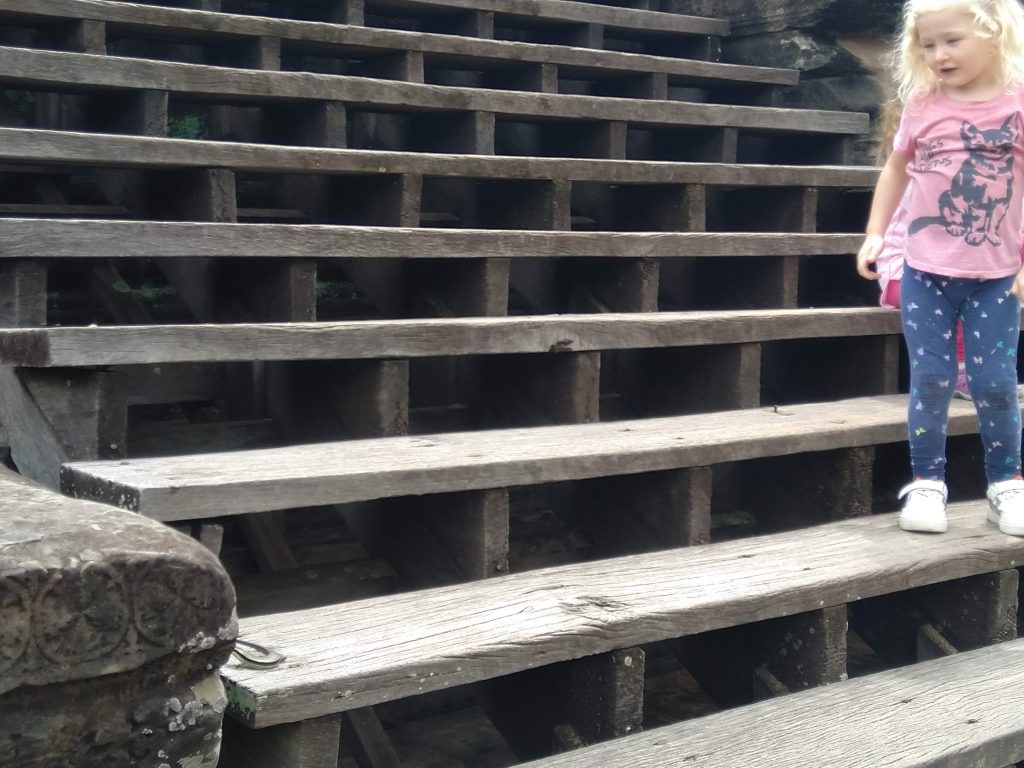
Catherine found a lizard on the exit. 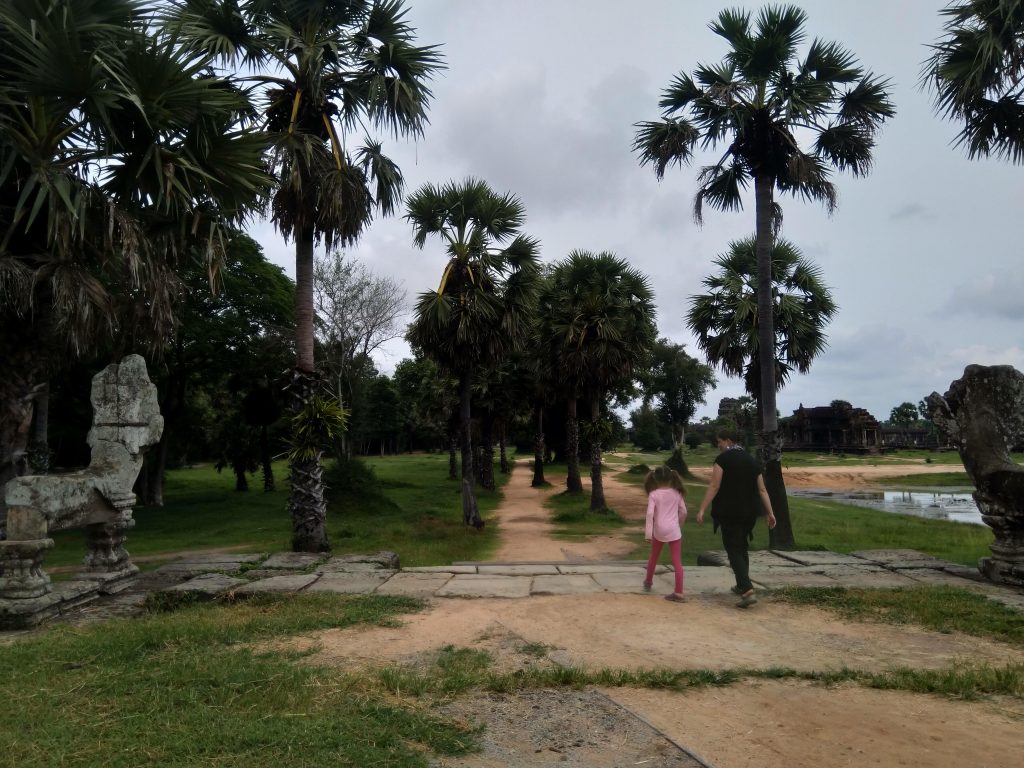
Crystal and Charlotte walking to the exist. 
Catherine preferred to ride.
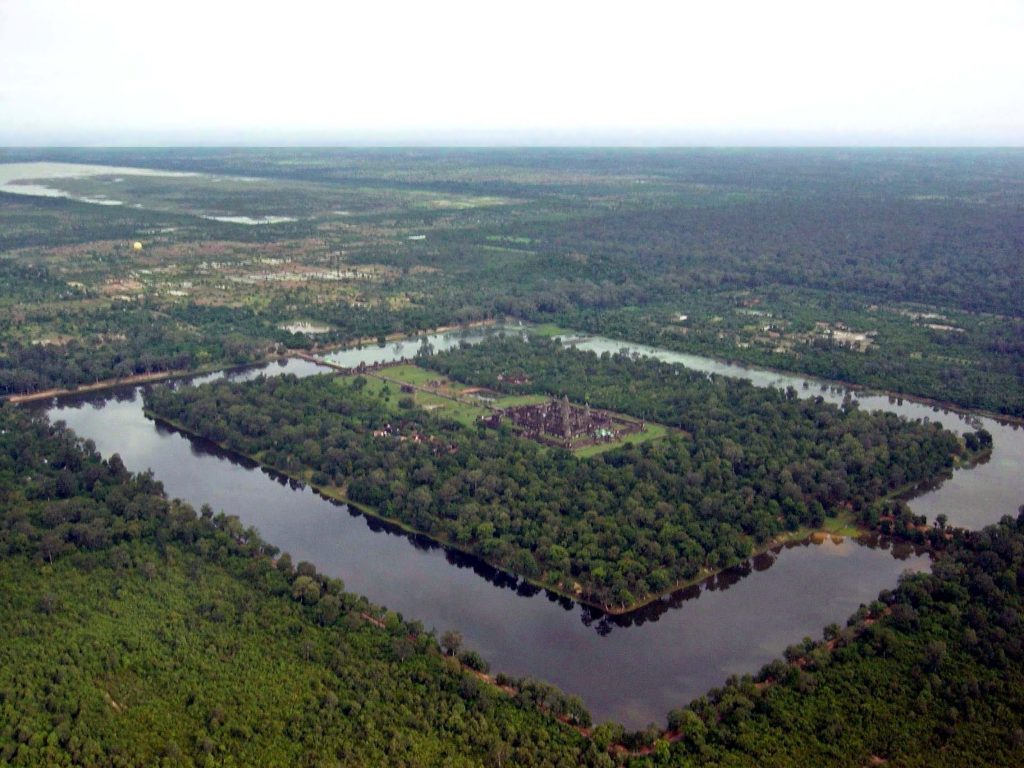
Amazing….what a gift to see it without the crowds!!!
Yes! It was wonderful for the girls! I don’t think they’d have the space to chase butterflies, find sunning lizards, and explore at their own pace normally.